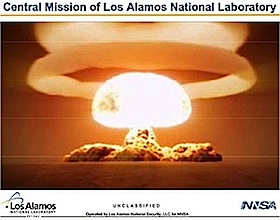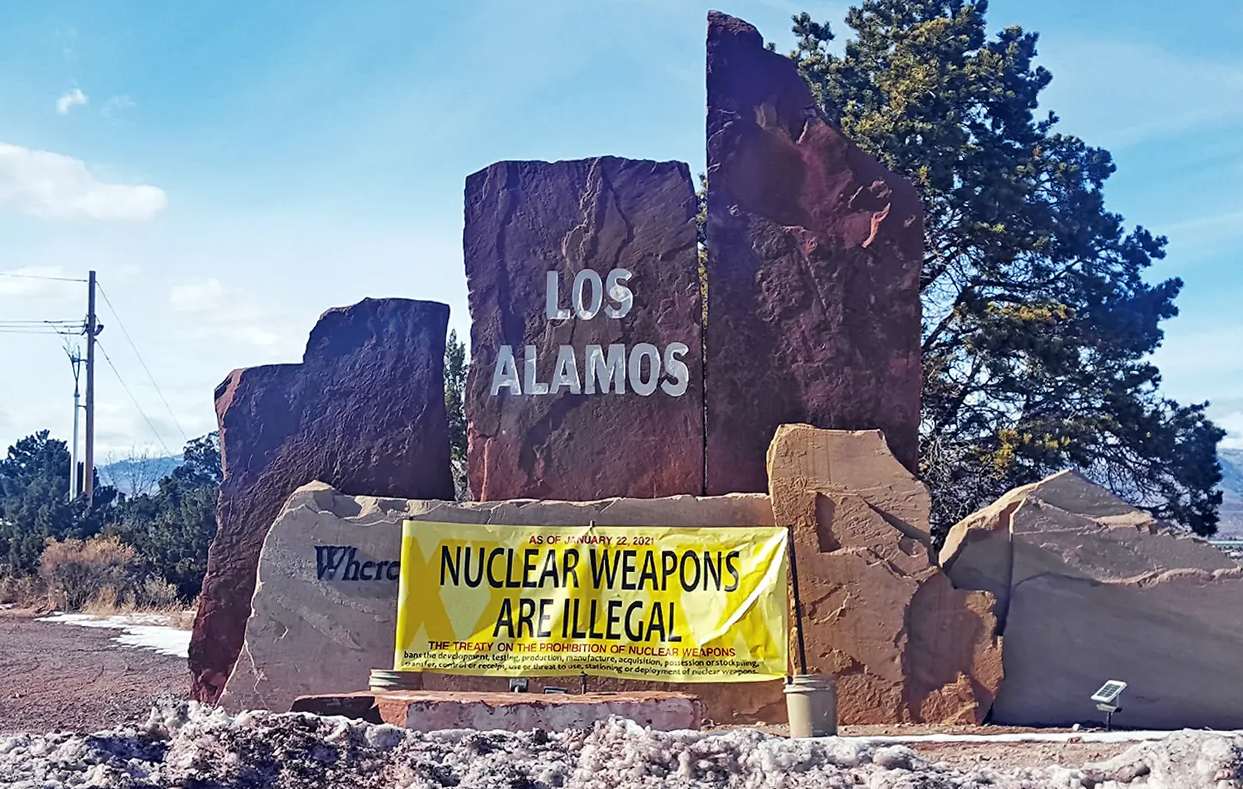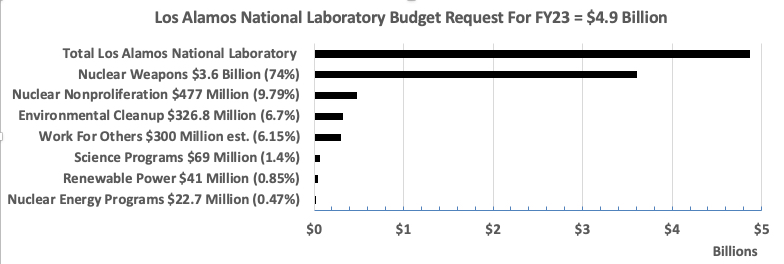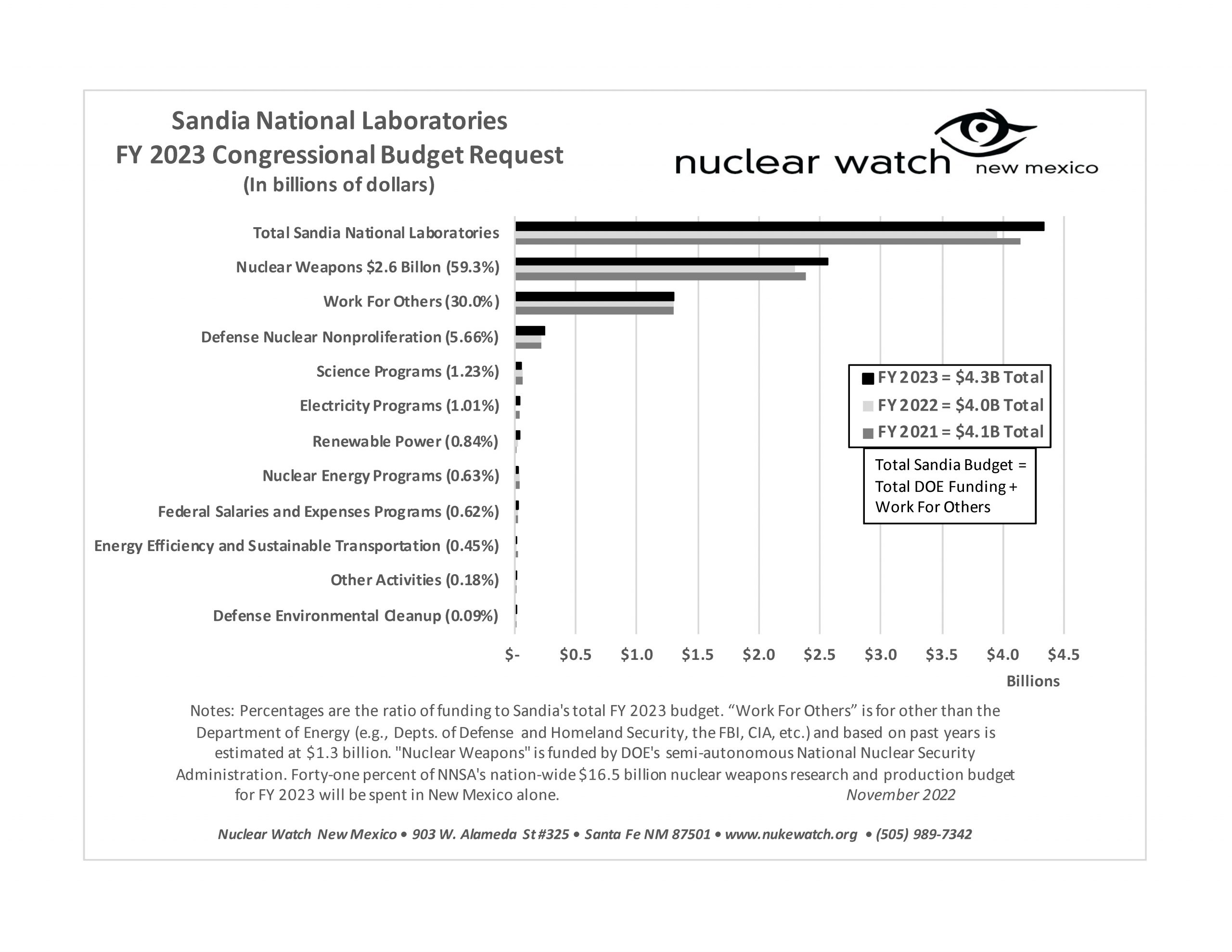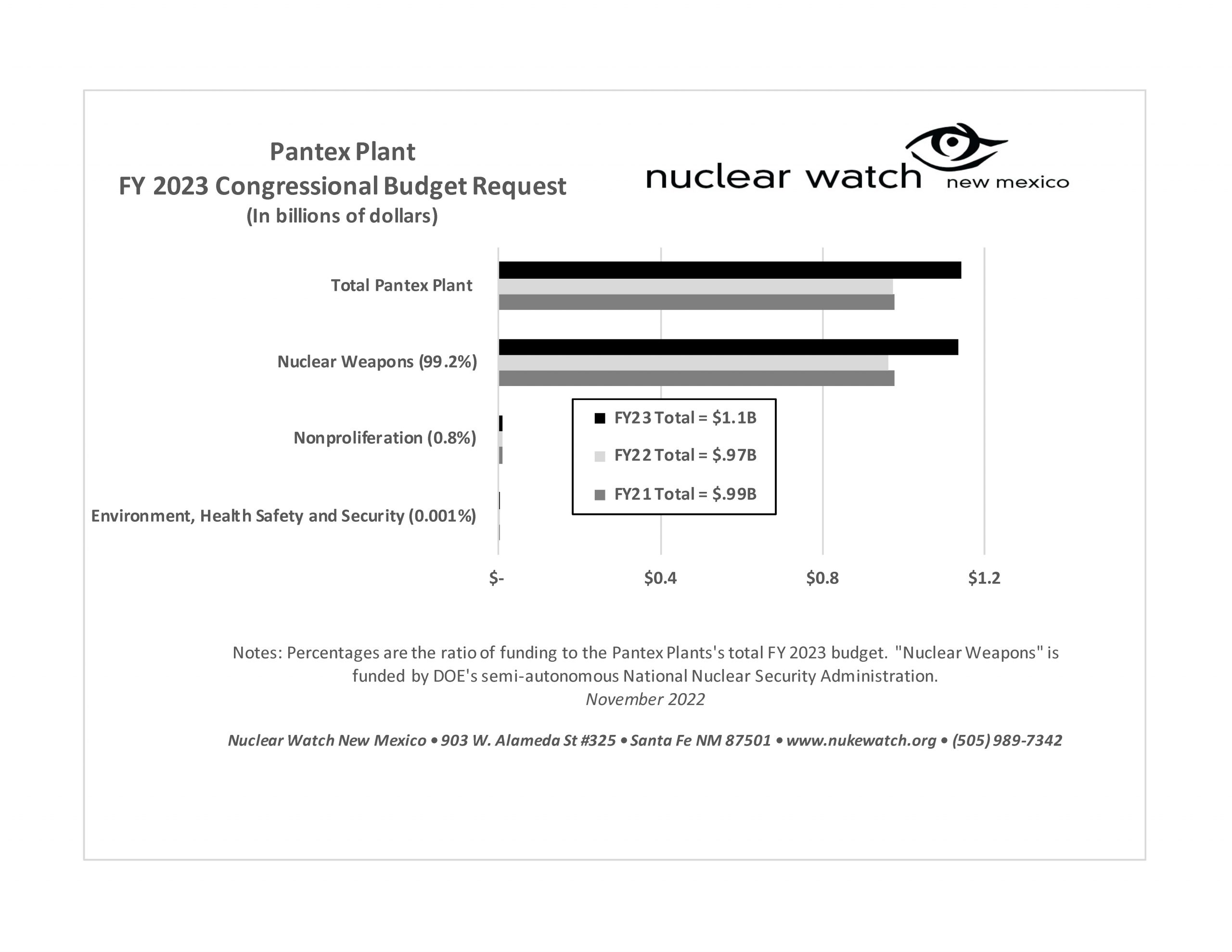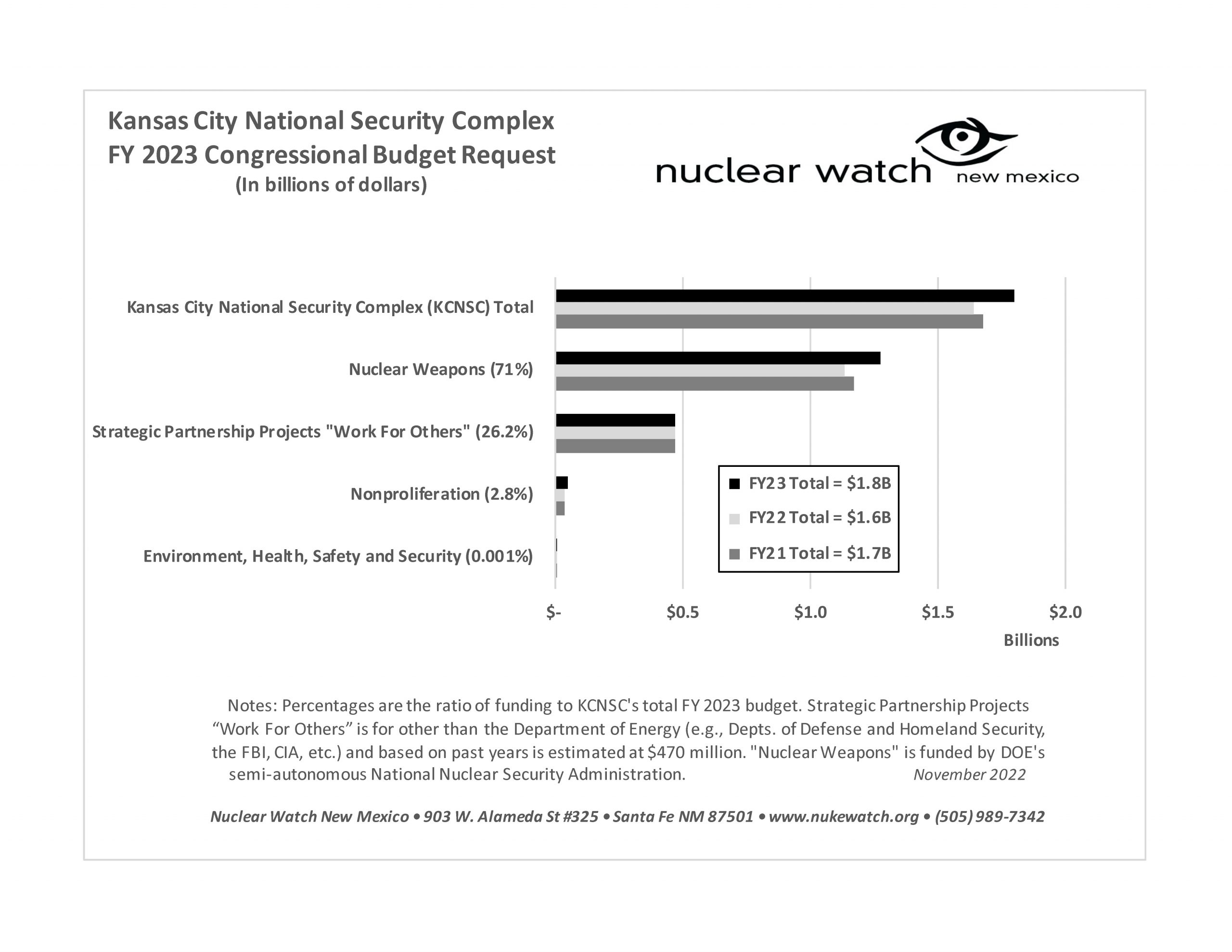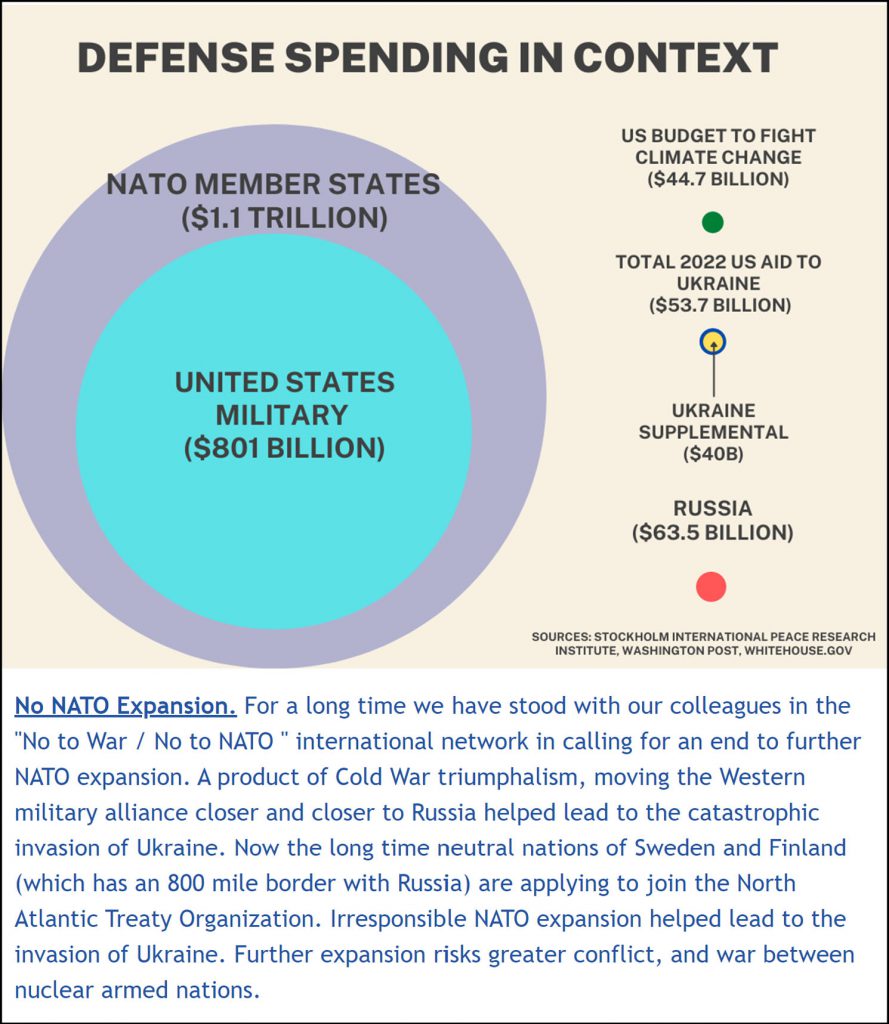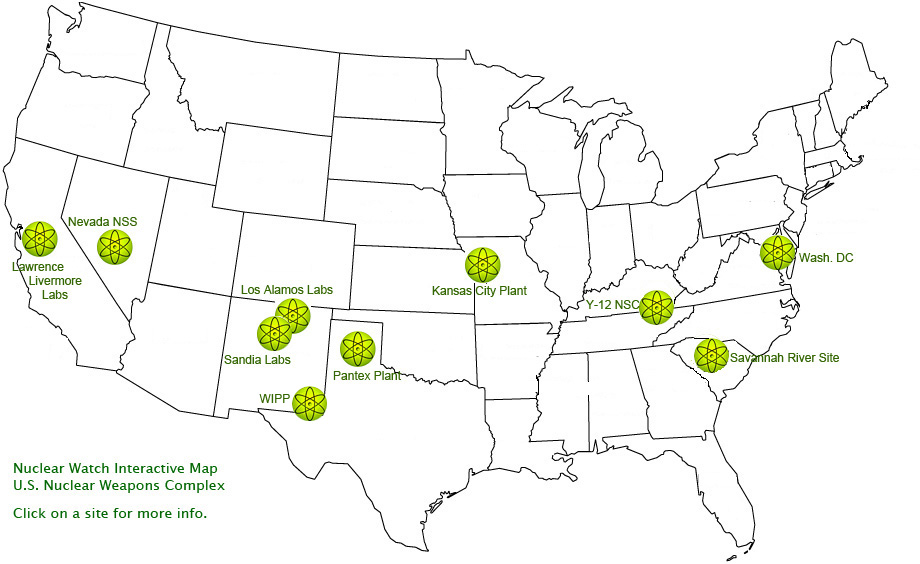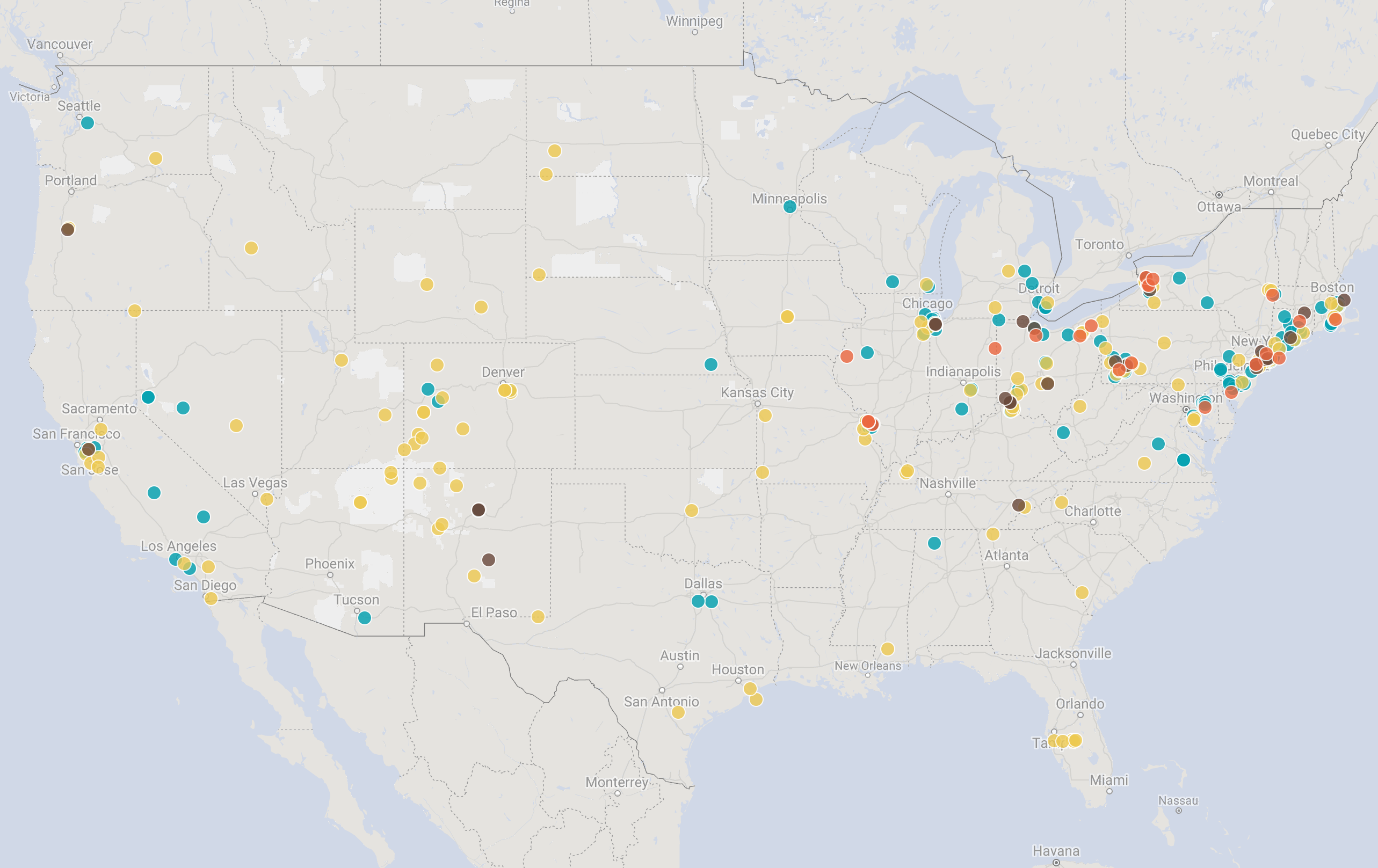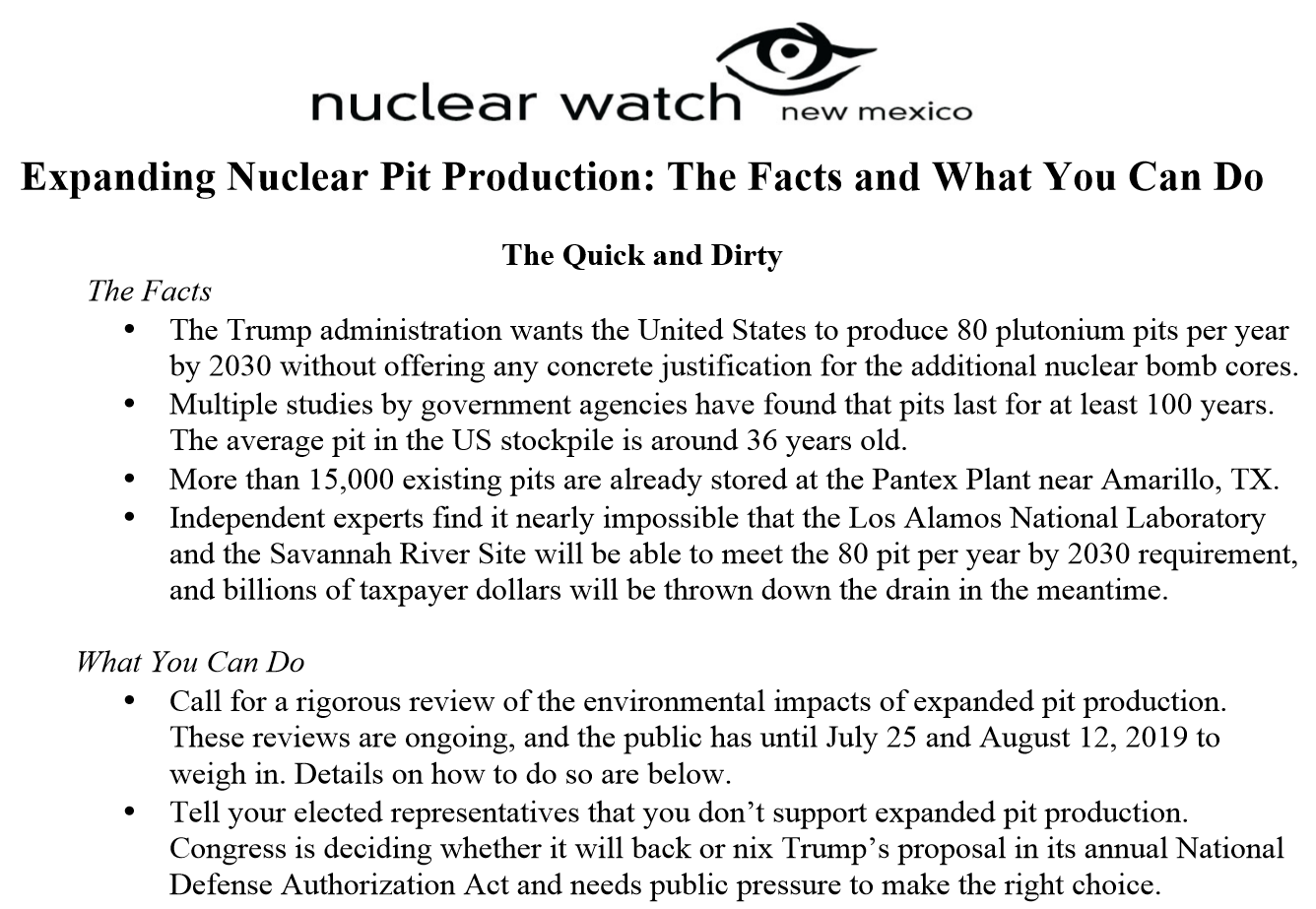QUOTE OF THE WEEK
Nothing Found
It seems we can’t find what you’re looking for. Perhaps searching can help.
LANL’s Central Mission: Los Alamos Lab officials have recently claimed that LANL has moved away from primarily nuclear weapons to “national security”, but what truly remains as the Labs central mission? Here’s the answer from one of its own documents:
LANL’s “Central Mission”- Presented at: RPI Nuclear Data 2011 Symposium for Criticality Safety and Reactor Applications (PDF) 4/27/11
Banner displaying “Nuclear Weapons Are Now Illegal” at the entrance in front of the Los Alamos National Lab to celebrate the Entry Into Force of the Nuclear Weapon Ban Treaty on January 22, 2021
Nothing Found
It seems we can’t find what you’re looking for. Perhaps searching can help.
Follow the Money!
Map of “Nuclear New Mexico”
Nuclear Watch Interactive Map – U.S. Nuclear Weapons Complex
In 1985, US President Ronald Reagan and and Russian President Mikhail Gorbachev declared that “a nuclear war cannot be won and must never be fought.”
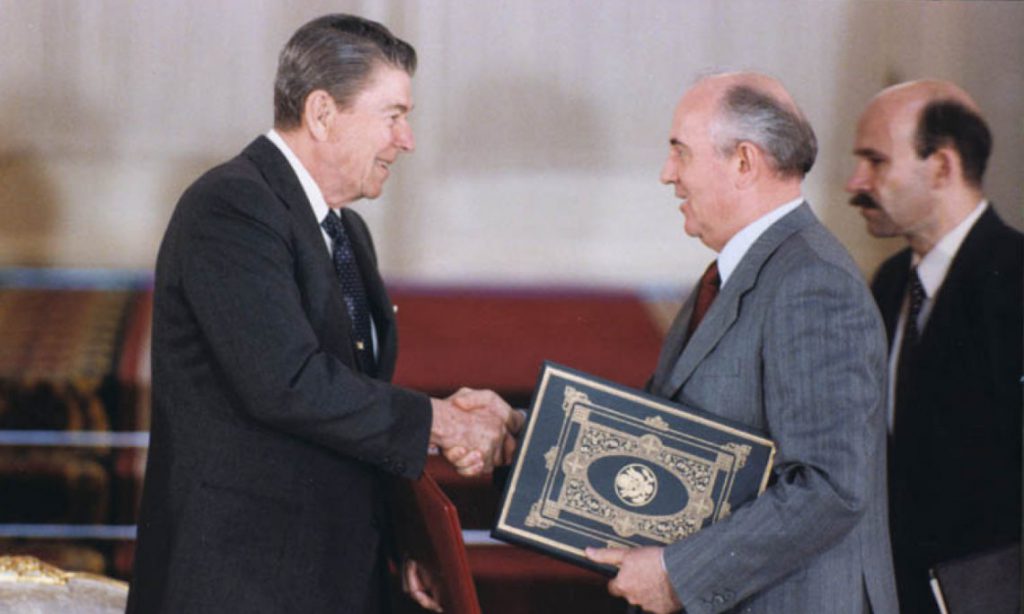
Waste Lands: America’s Forgotten Nuclear Legacy
The Wall St. Journal has compiled a searchable database of contaminated sites across the US. (view)
Related WSJ report: https://www.wsj.com
2022 BLOG POSTS
Nothing Found
It seems we can’t find what you’re looking for. Perhaps searching can help.
New & Updated
Class Action Suit Draws Big Crowd – Portsmouth Gaseous Diffusion Plant
“DOE is simply not to be trusted. Period.”
— Carlos Williams speaking about local cancer concerns.
He has lived for thirty years five miles from the Portsmouth, Ohio uranium enrichment plant.
BY TOM CORRIGAN | PORTSMOUTH DAILY TIMES © 2019 Portsmouth Daily Times, all rights reserved.
Their stories were extremely varied. But many had one unfortunate commonality: cancer.
A small portion of the crowd which lined up and waited hours Tuesday in the OSU Endeavor Center in Piketon.Larry and Janie Williams describe themselves as being fence line neighbors of the Portsmouth Gaseous Diffusion Plant since 1972. When she began to fall ill somewhat over four years ago, Larry said his wife’s doctor asked how she had come to be exposed to radiation. Janie never worked at the Portsmouth plant but spoke of daily hearing the ongoing construction of the decommissioned plant’s controversial on-site waste disposal facility. Janie said she developed a type of cancer that attacked her blood. Treatment included extremely expensive stem cell transplants. The transplants did buy her some time, though she added doctors gave her three to five years of life.
“I’m in year four,” said Janie, who clearly is accepting of her situation and spoke of her story unabashedly. She is 63.
Why SC is likely stuck with a stockpile of the nation’s most dangerous nuclear materials
POST & COURIER SPECIAL REPORT: LETHAL LEGACY
BY THAD MOORE & COLIN DEMAREST | postandcourier.com
South Carolina could be stuck with a massive stockpile of the nation’s most dangerous nuclear material for decades, despite a federal mandate and years of promises that the state wouldn’t become America’s plutonium dumping ground.
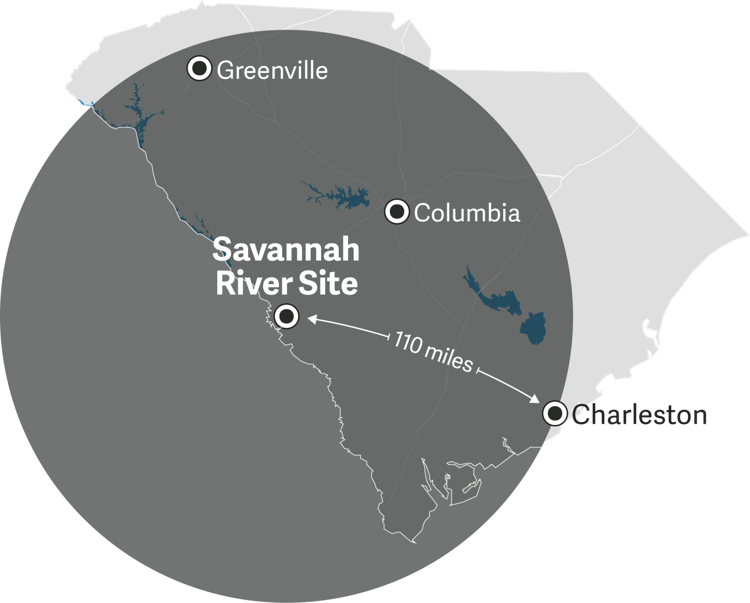 A restricted internal report obtained by the Aiken Standard and The Post and Courier suggests that the state is likely to become a long-term repository for enough plutonium to build the bomb dropped on Nagasaki nearly 2,000 times over.
A restricted internal report obtained by the Aiken Standard and The Post and Courier suggests that the state is likely to become a long-term repository for enough plutonium to build the bomb dropped on Nagasaki nearly 2,000 times over.
South Carolina faces this prospect despite a federal law that gives the U.S. Department of Energy just 2½ more years to remove its plutonium from the Savannah River Site, a huge swath of federal land along the Georgia border.
Hundreds gather in Piketon for town hall on alleged radioactive contamination
“[I] wanted to see what information is available,” Brandon Moore said. “What are we doing to help all these folks that are impacted or that may be impacted in the future?”
BY BRYANT SOMERVILLE. | 10tv.com
PIKETON, Ohio – People stood in line for hours, Tuesday, wanting to make sure they and their families were safe.
“I just want to make sure what’s going on if there was any contamination there or where we’re at,” Steve Copper said. “I want to make sure we got everything taken care of.”
“These materials are ounce-for-ounce the most dangerous materials known to man,” Stuart Smith said.
Smith is with Cooper Law Firm out of New Orleans. It was his firm that filed the lawsuit in May alleging Ohio residents near a former uranium enrichment plant in Piketon were exposed to radioactive contaminants that spread to other properties but were never informed.
Continue reading

Trinity: “The most significant hazard of the entire Manhattan Project”
“New Mexico residents were neither warned before the 1945 Trinity blast, informed of health hazards afterward, nor evacuated before, during, or after the test. Exposure rates in public areas from the world’s first nuclear explosion were measured at levels 10,000- times higher than currently allowed.”
Final Report of the Los Alamos Historical Document and Retrieval and Assessment Project, Prepared for the Centers for Disease Control and Prevention, November 2010, pp. ES-34-35. VIEW HERE
Victims of the Trinity Test remain uncompensated, yet the Los Alamos Lab continues to expand plutonium pit production.
BY KATHLEEN M. TUCKER & ROBERT ALVAREZ | thebulletin.org
For the past several years, the controversy over radioactive fallout from the world’s first atomic bomb explosion in Alamogordo, New Mexico on July 16, 1945—code-named Trinity—has intensified. Evidence collected by the New Mexico health department but ignored for some 70 years shows an unusually high rate of infant mortality in New Mexico counties downwind from the explosion and raises a serious question whether or not the first victims of the first atomic explosion might have been American children. Even though the first scientifically credible warnings about the hazards of radioactive fallout from a nuclear explosion had been made by 1940, historical records indicate a fallout team was not established until less than a month before the Trinity test, a hasty effort motivated primarily by concern over legal liability.
Trinity Test Anniversary
July 16th 2019 is the 74th anniversary of the first above ground nuclear bomb test on a U S civilian population. It was done near Tularosa New Mexico. The people were given no warning and have been subjected to 74 yrs of US government coverup and misinformation about the impact on them.
The Hoax That Nuclear Power is Green
This “Enviro Close-Up with Karl Grossman” demolishes the hoax that nuclear power is green. Continue reading
Wyoming lawmakers quietly explore storing spent nuclear fuel
Management Council votes by email to study housing spent nuclear fuel at Gas Hills, Shirley Basin to bring what a state senator says could be $1 billion a year.
Massive containers hold spent nuclear fuel at a dry storage facility. This photo shows, at right, a dry cask recently loaded with spent fuel being lifted from a horizontal transporter to be placed verticlaly on a specially designed storage pad. (Flickr Creative Commons/Sandia National Laboratories)ANGUS M. THEURMER JR. | wyofile.com
A legislative committee has appointed six of its members to investigate the idea with the U.S. Department of Energy, Sen. Jim Anderson (R-Casper) told WyoFile on Friday. Anderson is co-chairman of the Joint Minerals Business and Economic Development Committee which received approval and funding from the Legislative Management Council in an unannounced vote to study the issue before the next legislative session begins in early 2020.
Wyoming’s dependence on an ailing coal industry spurred talk about pursuing the temporary storage idea, Anderson said. Fuel rods would be housed in casks with two-foot-thick walls, he said.
US suspends low-level radioactive waste shipments to Nevada
BY SCOTT SONNER | time.com
(RENO, Nev.) — A Nevada congressman called for U.S. Energy Secretary Rick Perry’s resignation Wednesday after the department acknowledged multiple shipments of low-level radioactive waste to a site north of Las Vegas may have been mislabeled and out of compliance with safety regulations for years.
The department had announced earlier that shipments of the waste from Tennessee to Nevada have been suspended while it investigates whether the materials were “potentially mischaracterized” as the wrong category of low-level waste. Low-level waste can include equipment or worker’s clothing contaminated by exposure to radiation, while mixed low-level waste can include toxic metals.
America’s Indefensible Defense Budget
BY JESSICA T. MATTHEWS | nybooks.com
The sheer size of the military establishment and the habit of equating spending on it with patriotism make both sound management and serious oversight of defense expenditures rare.
As a democracy, we are on an unusual and risky path.
For several decades, we have maintained an extraordinarily high level of defense spending with the support of both political parties and virtually all of the public. The annual debate about the next year’s military spending, underway now on Capitol Hill, no longer probes where real cuts might be made (as opposed to cuts in previously planned growth) but only asks how big the increase should be.
NMED won’t move LANL Oversight Bureau office from Los Alamos
“New Mexico Environment Department (NMED) Secretary James Kenney and other members of the department’s staff held a public meeting July 8 to address fears that NMED would move the Los Alamos National Lab (LANL) Oversight Bureau field office out of Los Alamos.
In June, the department announced a proposal to move the field office to a Santa Fe location. The news was met with immediate backlash from LANL watchdog groups such as Concerned Citizens for Nuclear Safety and Nuclear Watch New Mexico.”
By Kendra Chamberlain | nmpoliticalreport.com
The department held the meeting, the first of a series of public outreach events the department plans to hold this year throughout the state, in part to assuage public concerns around the future of the Oversight Bureau’s field office in Los Alamos.
In June, the department announced a proposal to move the field office to a Santa Fe location. The news was met with immediate backlash from LANL watchdog groups such as Concerned Citizens for Nuclear Safety and Nuclear Watch New Mexico.
Kenney, along with Resource Protection Division director Stephanie Stringer and Administrative Services Division director Michelle Desmond, explained some of the factors behind the contemplated move in a short presentation to audience members.
“[There] was never the intent to decrease oversight, or lessen any compliance or enforcement [over LANL],” Stringer told audience members.
“A lot of people [thought] when they heard we were moving off the hill, that it meant less oversight. There is no doubt in my mind that Secretary Kenney has made it my job to absolutely make sure compliance and enforcement and oversight of these facilities are top priority,” she said.
What public engagement?
This article was originally published July 6, 2019 in the Santa Fe New Mexican
Article Written by NukeWatch NM Volunteer: ALICIA SANDERS-ZAKRE
The Department of Energy’s new attempt at “enhanced public engagement” on legacy nuclear waste cleanup at Los Alamos National Laboratory failed both its stated objectives to consider public input and provide public education. To turn things around, officials should actually listen to public attendees and provide complete information at future meetings.
In the two-hour June 26 forum in Los Alamos, officials from the department’s Environmental Management Los Alamos Field Office, alongside N3B, the contractor tasked with implementing the cleanup, repeatedly proclaimed their interest in hearing from the public and pledged total transparency, but they didn’t give anyone in the packed room a chance to speak.
Renewables Catching Nuclear Power In Global Energy Race
Coal is still the dominant source of electricity around the world, although natural gas has taken over the top spot in the U.S. But, renewables have grown rapidly over the past decade, and are on the cusp of overtaking nuclear globally.
From 2007 to 2017, the Renewables category grew at an average annual rate of 16.4%. But within that category, power from geothermal and biomass grew at an annual average of 7.1%. Wind and solar power, by contrast, grew at an annual average of 20.8% and 50.2%, respectively, over the past decade.
In 2018, nuclear power was responsible for 2,701 Terawatt-hours (TWh) of electricity generation, compared to 4,193 TWh for hydropower and 2,480 for renewables.
ACTION ALERTS
Nothing Found
It seems we can’t find what you’re looking for. Perhaps searching can help.
Nothing Found
It seems we can’t find what you’re looking for. Perhaps searching can help.
Interfaith Panel Discussion on Nuclear Disarmament - August 9
Nothing Found
It seems we can’t find what you’re looking for. Perhaps searching can help.
New Nuclear Media
Nothing Found
It seems we can’t find what you’re looking for. Perhaps searching can help.

